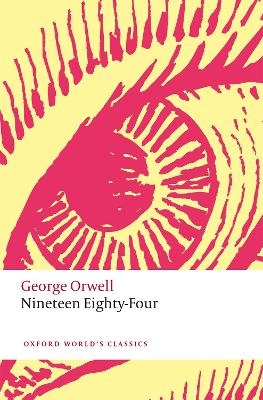
Nineteen Eighty-Four
Seiten
2021
Oxford University Press (Verlag)
978-0-19-882919-5 (ISBN)
Oxford University Press (Verlag)
978-0-19-882919-5 (ISBN)
1984 Nineteen Eighty-Four (1949) was George Orwell's final novel and was completed in difficult conditions shortly before his early death. It is one of the most influential and widely-read novels of the post-war period.
'If you want a picture of the future, imagine a boot stamping on a human face--forever.'
1984 Nineteen Eighty-Four (1949), George Orwell's final novel, was completed in difficult conditions shortly before his early death. It is one of the most influential and widely-read novels of the post-war period, and has been a huge international bestseller over many decades. Continually in print, it has long been controversial, both in its immediate Cold War context and in later history.
It is in some ways a realist novel, but in others is more akin to a work of science fiction, a dystopia or a satire. It also has strong affiliations to Gothic in its plotting, motifs and affective states. Full of horror and terror, it contains prophetic dreams and a central character who thinks of himself as a 'monster', a 'ghost' and 'already dead'. Like Frankenstein and Dracula, it is fascinated by the power of a documentary remnant addressed to an unknown reader.
'If you want a picture of the future, imagine a boot stamping on a human face--forever.'
1984 Nineteen Eighty-Four (1949), George Orwell's final novel, was completed in difficult conditions shortly before his early death. It is one of the most influential and widely-read novels of the post-war period, and has been a huge international bestseller over many decades. Continually in print, it has long been controversial, both in its immediate Cold War context and in later history.
It is in some ways a realist novel, but in others is more akin to a work of science fiction, a dystopia or a satire. It also has strong affiliations to Gothic in its plotting, motifs and affective states. Full of horror and terror, it contains prophetic dreams and a central character who thinks of himself as a 'monster', a 'ghost' and 'already dead'. Like Frankenstein and Dracula, it is fascinated by the power of a documentary remnant addressed to an unknown reader.
John Bowen is a Professor of English at the University of York. He has written widely on nineteenth-century and twentieth-century literature; his publications include Other Dickens: Pickwick to Chuzzlewit (OUP, 2000) and editions of Barnaby Rudge for Penguin and Trollope's Barchester Towers and Phineas Redux for Oxford World's Classics.
Introduction
Note on the Text
Select Bibliography
Chronology
1984 Nineteen Eighty-Four
Explanatory Notes
| Erscheinungsdatum | 08.04.2021 |
|---|---|
| Reihe/Serie | Oxford World's Classics |
| Verlagsort | Oxford |
| Sprache | englisch |
| Maße | 130 x 196 mm |
| Gewicht | 208 g |
| Themenwelt | Literatur ► Klassiker / Moderne Klassiker |
| Geisteswissenschaften ► Sprach- / Literaturwissenschaft ► Literaturwissenschaft | |
| ISBN-10 | 0-19-882919-1 / 0198829191 |
| ISBN-13 | 978-0-19-882919-5 / 9780198829195 |
| Zustand | Neuware |
| Haben Sie eine Frage zum Produkt? |
Mehr entdecken
aus dem Bereich
aus dem Bereich
Buch | Softcover (2020)
Beuth (Verlag)
CHF 27,85


